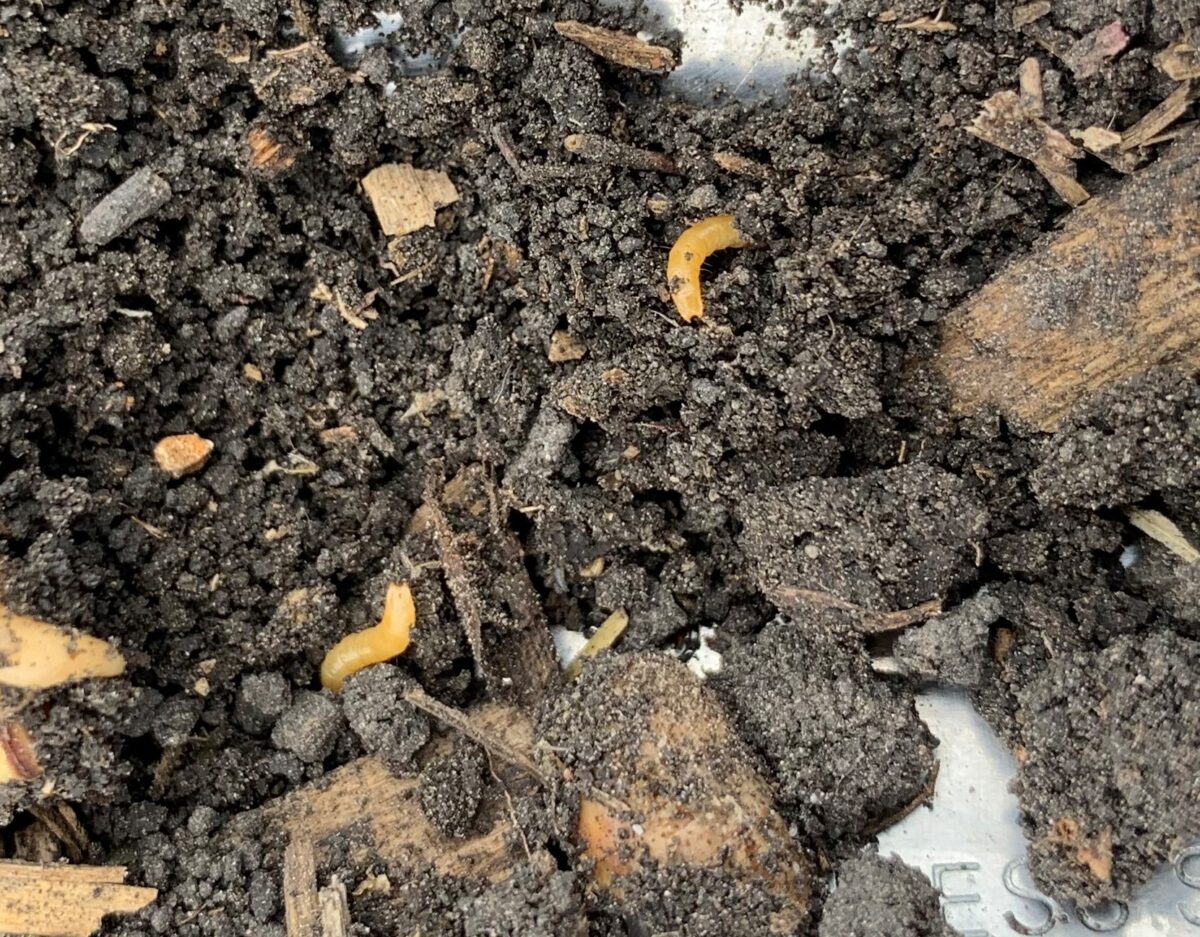Photo credit: Megan Bourns
Wireworm (Limonius spp., Agriotes spp., Hemicrepidius spp., and others)
Crops at risk of wireworm damage are primarily corn and cereals, and occasionally/rarely soybeans, forages, dry edible beans and canola.
Description
Wireworms are larvae that are 2–40 mm (0.1–1.6 in) long, cylindrical, copper-brown-coloured and hardened with a distinct fat head.
Adult wireworms are elongated dark-bodied (brown, charcoal or black) beetles that are 8–20 mm (0.3–0.8 in.) and have the ability to flip themselves upright when placed on their backs. As they flip, there is an audible click, giving them their name “click beetles.”

Wireworms, depending on the species, take up to 6 years to develop from egg to adult, spending most of their life as larvae. They overwinter as larvae in the soil below the frost line. When soil temperatures warm to 10°C in the spring, the larvae move to the surface to feed. Due to their long life cycle, the larvae can damage several successive crops, feeding on the roots of weeds, grasses and crop plants. Once soil temperatures reach approximately 26°C, and soil moisture decreases, the larvae migrate downward and may be difficult to find in the summer. Once soil temperatures cool again in the fall, larvae may migrate back to the soil surface to feed on roots until moving downward again to overwinter. The larvae that have reached the end of their cycle will pupate and become adults in the summer, which then lay their eggs at the base of grassy weeds.
Damage
Wireworms are most active during the months of April to June and occur most often in fields that have little soil disturbance. The larvae attack roots, seeds and germinating seedlings of many crops, such as corn, soybeans, spring cereals, dry edible beans and potatoes. Non-uniform growth or gaps in the stand may be due to wireworm feeding on germinating seeds. Injured seedlings appear stunted and wilted, with leaves sometimes becoming purple or blue at the tips. Wireworms are rarely a problem in fall-planted cereals, however, they can be serious in spring-planted grains.
Conditions that increase risk include sandy and silty soils with high frequency of grassy crop rotation (cereals, mixed forages, and especially following sod), canola or vegetable crops including carrots, potatoes and sweet potatoes. Fields with grassy weeds or following summer fallow are also at risk. More crop injury occurs in cool, wet springs when crop emergence is slowed.
Scouting
The best time to scout is in the fall or spring when soil temperatures are just above 10°C, but below 26°C. Baits are most effective at approximately 10°C, since the bait ferments and releases CO2 to attract wireworms. Warmer soil temperatures will cause the wireworms to be more attracted to other vegetation in the soil. There may be specific regulations in Ontario for access to neonicotinoid treated seeds for protection against wireworms, which are not described here.
Scouting can be conducted by establishing bait stations in high-risk area of the field. High-risk areas include sandy or silty knolls, areas with grassy weed patches or problem areas of the field where gaps in the stand have been noticed. Dig a hole at each station, approximately 15 cm (6 in.) wide and deep. Take 1 cup of all-purpose four, or 1 cup of equal parts of untreated corn, wheat and bean seeds soaked overnight and drop it into the hole. Bury the bait, breaking up any soil clumps, and mound the soil over the bait to prevent standing water. If soil temperatures are still cool, place a black plastic bag over the bait station and cover the edges with soil or rocks. Place a flag at the bait station to make it easier to find again. Return to the bait traps 7 days later to dig up the baits and determine the presence of wireworms. One wireworm per bait trap indicates the need for an insecticide seed treatment or soil-applied insecticide. Millipedes may also be found in the baits; be sure millipedes are not being mistakenly identified as wireworms.
Management Strategies
- Use insecticide seed treatments or in-furrow soil insecticides in fields that have reached threshold, have a history of wireworm incidence or are following grassy sods.
- Avoid planting a cereal or corn crop following sod or pasture. Non-host crops include alfalfa, pulse crops, and buckwheat.
- Control grassy weeds in previous year’s crop when a susceptible crop is to follow.
- Increase the seeding rate by up to 10% to compensate for the potential yield loss.
- Plant in warm, moist conditions, which help the crop to emerge and establish quickly.
- Predators and pathogens play a minor role in controlling wireworm populations.
- No rescue treatments are currently available.

